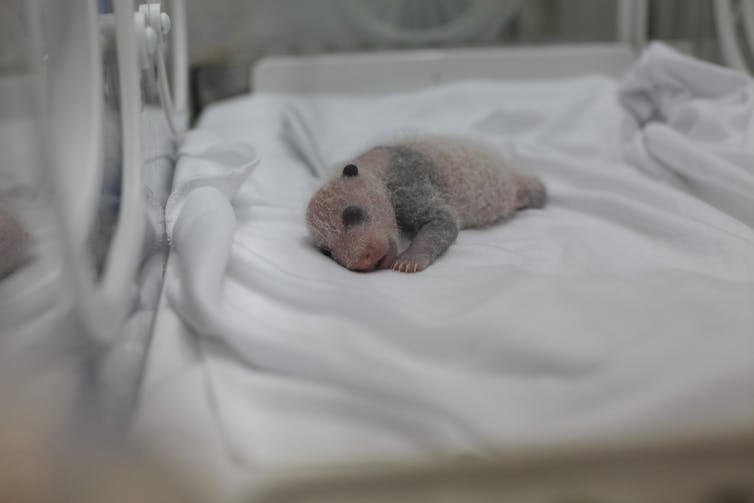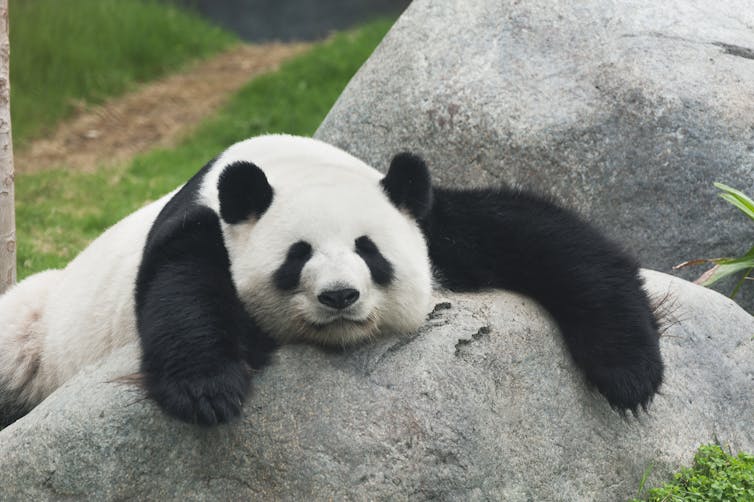Forty years after giant panda numbers reached an all-time low, specialists around the world are still trying to develop a self-sustaining population in captivity that can be released into the wild to secure the animal’s future.
This has been hampered over the years by institutions failing to work together and follow the breeding recommendations of genetic scientists. In China in particular, the home of giant pandas, breeders have prioritised cub numbers over quality. The problem is that the competing ministries responsible for panda populations are paid for each cub they produce.
There have long been concerns that breeding pandas in the wrong way produces cubs in captivity with health and behavioural problems. These problems exacerbate the difficulties of giant panda reproduction and make them less capable of coping in the wild.
We have just published new research into panda milk that adds to the growing evidence of how human interference can be bad for these animals. It relates to the fact that in China it is standard practice in breeding centres to intensively supplement – or even entirely replace – the mother’s milk with an artificial substitute. In Chinese husbandry culture, the belief is that this is the best way of ensuring the cubs have the best chance of survival and grow as quickly as possible.
Practices vary in other countries, often depending on the nature of the panda loan agreement they have with the Chinese authorities. In many cases, they are required to have a Chinese zookeeper overseeing the pandas at all times, in which case they will follow Chinese practice. (One example of a zoo that doesn’t interfere with panda milk is Vienna).
The colostrum conundrum
Milk is particularly important for giant pandas because of the extreme immaturity of a newborn panda cub. All bears are born more developmentally immature than any other mammal apart from marsupials, and of the seven bear species, giant pandas are born most immature of all.
Newborn pandas weigh only 100-150g, about 1/1,000th the weight of their mothers. They have no functioning immune system, cannot see or hear, and cannot regulate their own body temperature. They are naked and completely dependent on the mother for every aspect of survival and development.

As readers with children will be well aware, mothers produce a special milk in the first few days after giving birth which is unique in its composition of specific nutrients. Known as colostrum, this first milk contains specific types and concentrations of substances essential for the newborn’s immune system, as well as proteins, lipids and other molecules that are vital for development.
In species that are born fairly mature, such as calves and foals, the colostrum phase of milk lasts only a few hours. In our new paper, which is the third in a series of papers about giant panda milks, we hypothesised that the transition from colostrum to mature milk would be unusually long in bears in order to meet the requirements of a developmentally immature newborn. Sure enough, when we analysed milk samples from six giant pandas, the colostrum phase turned out to last 30 to 40 days.
We also found that the composition of the milk varied greatly over the period, with some ingredients starting off in large proportions and falling away while others started low and rose dramatically. Some of the most noticeable changes related to small molecules that are building blocks for the eye, brain and nervous system.
Other fluctuating ingredients are integral to cubs’ biosynthetic pathways, cell membranes, antibacterial defences and establishing microorganisms in their digestive system. These microorganisms may be particularly important to giant pandas as they progress from a milk-based to a predominately vegetarian diet within the first year of life: giant pandas may depend on a unique gut microbiome to be able to digest the large quantities of bamboo that form the foundation of their diet.
We also analysed the artificial milk formulae that breeders commonly use to supplement giant panda cubs. We found that key compounds were at extremely inappropriate levels – some too low, others too high. They also stayed at these levels, not changing like the mother’s colostrum to meet the needs of the developing infant.
For example, we discovered that the artificial milk had a gross excess of lactose, which is abundant in cow and other milks but disappears from panda colostrum after the first day or two. This lactose causes panda cubs severe stomach problems and disrupts the fragile balance of microorganisms in their gut, which can hamper their digestive processes for the rest of their lives.
At the same time, we found major deficiencies in other key compounds in the artificial milk that may be compromising the development of the cubs’ brains, eyes and other organs – a grave risk considering the ultimate intention is to release captive-bred individuals into the wild.

The wider problem
In the wild, panda mothers invest extraordinary time and skill rearing their infants to be sufficiently adaptive and resilient to survive. We still have a great deal to understand about this process, and our research reveals what is probably one of a number of ways in which panda cubs suffer when breeders prevent panda mothers from raising their cubs undisturbed.
It is probably equally unhelpful, for example, that panda families are interfered with hourly and live in barren enclosures where mothers have no privacy or control over their environment. At three to five months of age, cubs bred in captivity are permanently removed from their mothers to maximise the chances of the mothers reproducing every year. This is very different from the wild, where cubs stay with their mothers for at least two and a half years and females reproduce only every four to five years.
If we wish to build a captive panda population of bear cubs that are physically, cognitively and behaviourally healthy, breeders need to leave mothers to their work. Our research emphasises the evolutionary wisdom that no one else is better suited to that job.

